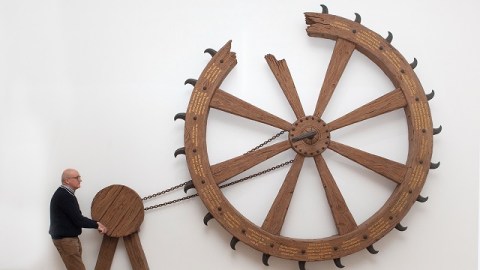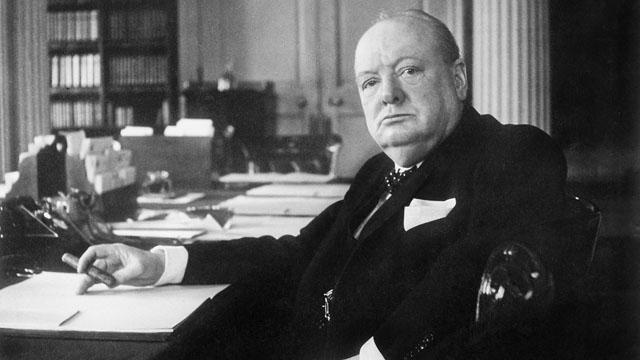Seeing the Funny Side of Sainthood

When the Vatican recently cleared both Pope John XXIII and Pope John Paul II for sainthood—a hyper-holy two-fer—critics all along the political spectrum grumbled over the honoring of one man or the other. Like the chipped and worn statues of Christian antiquity, the image of sainthood’s taken a beating over the centuries. Just as modern medicine’s makes the required miracles harder to come by, modern cynicism sees more flaws than faith. Michael Landy: Saints Alive, which runs through November 24, 2013 at the National Gallery, London, puts a modern spin on the sainthood system through a series of kinetic sculptures designed not to move you towards piety but to move you to a new perspective on what it means to elevate a person to spiritual superstardom. By seeing the funny side of sainthood, Landy pokes fun at the past while also warning us about the idolatry of the present.
Landy hails from the ranks of the once, but now in name only Young British Artists. Like fellow YBAs Damien Hirst and Tracey Emin, Landy’s now more of an establishment insider than the cultural bomb-thrower of the late 1980s/early 1990s. For the past two years, Landy’s been the National Gallery Rootstein Hopkins Associate Artist in residence, which requires the recipient “to demonstrate the continuing inspiration of the Old Master tradition on today’s artists.” Hence, Saints Alive, in which Landy adapts his magpie approach to cultural commentary by scrounging around the National Gallery’s own collection of saintly imagery, adding the detritus of modern life here and there, mixing in a dash of Monty Python-esque humor, and arriving at a mainstream audience-friendly skewering of sainthood.
Landy literally cuts up the way saints were once seen and creates a motley collage for a new perspective. (You can see a slideshow of Landy’s methods in his National Gallery-provided studio here.) Working with high-quality, large-scale reproductions of the National Gallery’s own Saint Jerome (1476) by Carlo Crivelli, Saints Genevieve and Apollonia (1506) by Lucas Cranach the Elder, The Stigmatization of Saint Francis (1437–44) by Sassetta, and Saint Jerome (1470) by Cosimo Tura, Landy dismembers the saints and then casts old machinery, cogs, and wheels from garage sales and flea markets between the parts. Landy’s choice of raw materials emphasizes his workmanlike approach to both the old art and the new junk—no El Greco or shiny i-something technology to distract the eye.
The final element of each kinetic sculpture is the museumgoer. Foot cranks allow the patron to bring the sculptures, the saints, and the sarcasm to life. In Spin the Saint Catherine Wheel and Win the Crown of Martyrdom (shown above), Landy riffs on Pintoricchio’s Saint Catherine of Alexandria with a Donor (ca. 1480–1500). When visitors spin the fiberglass “Catherine Wheel,” they “reenact” the act of her martyrdom, but now as part of some grotesque game show. Saint Catherine’s an apt choice for a sardonic show about saints specifically because of the speciousness of her very existence. Probably a composite female martyr figure cobbled together over centuries of oral tradition, Saint Catherine nonetheless starred as a intermediary between the faithful and God the Father during the Middle Ages. Landy’s wheel rewards the modern viewer with episodes of Catherine’s fictional life—the same empty promises bestowed upon the Middle Ages believer who provided prayers and often payment for intercessions. Catherine’s Wheel thus becomes a circular argument—we believe because she’s holy, she’s holy because we believe.
Michael Landy: Saints Alive offers a fascinating complementary angle to one of Landy’s earliest hit installations—1995’s Scrapheap Services. In Scrapheap Services, Landy created a fictional company (complete with logo and motto, “We leave the scum with no place to hide”) specializing in “cleaning up” those members of society who fail to contribute. As the company’s promotional video explained, “A prosperous society depends upon a minority of people being discarded … Make a clean sweep with Scrapheap Services. We make people black-spots a thing of the past … Help us to help you dispose of people who no longer play a useful role in life … Our ideal landscapes are free of imperfections.” Landy’s installation featured hazmat suit-wearing mannequins sweeping up tiny people cut out from aluminum cans, food wrappers, and cigarette packs he found while dumpster diving. If Scrapheap Services made us think about those society treats like imperfect trash, Saints Alive makes us think of those society treats like perfect gods on Earth. To use the current equation, if society’s split into the 99% and the 1%, how many from that 99% secretly (or not so secretly) idolize the 1%? Are we still trapped in the Middle Ages mindset that no matter how hard we spin things, we remain in the same place, with the same saints and sinners ruling and being ruled, respectively?
Despite the obvious humor of Michael Landy: Saints Alive, Landy’s saying some important things about current society by juxtaposing it with the works of the past. By delving into the Old Masters’ takes on sainthood, Landy shows us how the new masters of the contemporary global economy take by tapping into a similar faith of the masses. Growing up severely Catholic myself, I flashed back to all my childhood memories of saints and their symbols while looking at Landy’s sculptures. (Saint Lucy and her eyes on a platter haunt me still.) But Landy’s look at these saints brought them alive for me once again and gave me (and perhaps will give you) new eyes to see that old world as well as the world today.
[Image:Michael Landy. Spin the Saint Catherine Wheel and Win the Crown of Martyrdom, 2013. Mixed media. 371 x 440 x 84 cm. Michael Landy, courtesy of the Thomas Dane Gallery, London. © Michael Landy, courtesy of the Thomas Dane Gallery, London / Photo: The National Gallery, London.]
[Many thanks to the National Gallery, London, for providing me with the image above and other press materials related to Michael Landy: Saints Alive, which runs through November 24, 2013.]
[Many thanks to Hugh, my eyes in London, for pointing out this exhibition to me and sharing his insights.]





